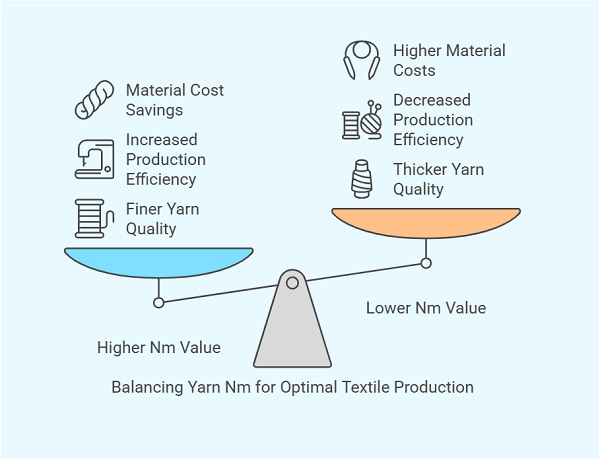Metric Count (Nm)
© Yarn Count Ltd. All rights reserved.
Disclaimer: All tools in the Yarn Count have been reviewed by the relevant spinning industry experts.
The Formula for Metric Count (Nm) Calculator:
Nm = Length (meters)Weight ÷ (grams)
Where:
- Nm = Metric Count (Number of hanks of 1000 meters per 1 gram)
- Length = Total length of the yarn in meters
- Weight = Total weight of the yarn in grams
Table of Contents
What is Metric Count (Nm)?
Metric Count (Nm) is a standard measurement used in the textile industry to express yarn fineness. It represents the number of meters per gram of yarn. A higher Nm value means a finer yarn, while a lower Nm value indicates a thicker yarn.

- Nm 10 means 10 meters of yarn weigh 1 gram.
- Nm 30 means 30 meters of yarn weigh 1 gram.
Textile engineers and manufacturers use Nm to select suitable yarns for different fabrics and production processes.
Why Metric Count (Nm) Matters
Metric count is an essential factor in textile manufacturing. It affects fabric quality, production efficiency, and material cost.
1. Fabric Quality
Yarn thickness influences fabric texture, softness, and strength. Finer yarns (higher Nm) create smoother, lightweight fabrics, while thicker yarns (lower Nm) produce heavier and more durable textiles.
2. Production Efficiency
Choosing the correct Nm ensures that textile machines run smoothly without excessive breaks or faults. Machines must be set according to yarn count to maintain consistent production speeds.
3. Cost and Material Optimization
Accurate Nm selection helps manufacturers control material usage. Finer yarns cover more fabric area with less weight, reducing material costs in large-scale production.
Converting Metric Count (Nm)
Metric Count (Nm) is often converted into other yarn count units based on different textile systems worldwide. The most common conversions include Tex, Denier, and Cotton Count (Ne).
Conversion Formulas
- Nm to Tex:
Tex = 1000 / Nm
Example: Nm 20 → Tex = 1000 / 20 = 50 Tex - Nm to Denier:
Denier = 9000 / Nm
Example: Nm 30 → Denier = 9000 / 30 = 300 Den - Nm to Cotton Count (Ne):
Ne = Nm / 1.69
Example: Nm 40 → Ne = 40 / 1.69 ≈ 23.67 Ne
How to Use the Metric Count (Nm) Calculator

Our calculator simplifies these conversions instantly. Follow these steps:
- Enter the Nm Value – Input the known metric count of your yarn.
- Select the Desired Unit – Choose Tex, Denier, or Cotton Count.
- Get the Result – The calculator will display the converted yarn count value.
This tool saves time and minimizes manual calculation errors, ensuring precision in textile planning.
Common Applications of Nm in Textiles
Metric Count (Nm) plays a key role in various textile sectors.
1. Spinning Mills
Spinning mills use Nm to categorize and sell yarn. Each yarn type has a specific Nm range suitable for different fabric types.
2. Weaving and Knitting
Manufacturers adjust machines according to Nm values to maintain fabric consistency. Different Nm values create varied fabric weights and textures.
3. Sewing Thread Production
Sewing threads require specific Nm values for strength and smooth stitching. Lower Nm values are used for heavy-duty sewing, while higher Nm values work best for fine stitching.
Choosing the Right Yarn Count
Selecting the right Nm depends on fabric type and end-use.
- Lightweight Fabrics (Shirts, Dresses) → Nm 40+
- Medium Fabrics (Trousers, Bedsheets) → Nm 20-40
- Heavy Fabrics (Denim, Upholstery) → Nm 10-20
Using the correct Nm ensures durability and comfort in the final product.
Conclusion
Metric Count (Nm) is a crucial yarn measurement in textiles. It helps determine yarn fineness, influences fabric properties, and ensures accurate material usage. Using a Metric Count (Nm) Calculator simplifies conversions, improves production accuracy, and enhances efficiency in textile manufacturing.